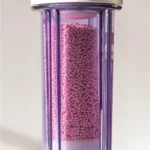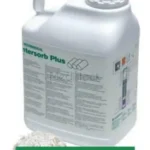PH is simply a measure of the acidity or alkalinity of any solution, including saltwater.
A PH of 7 is neutral, and the water is neither acidic nor alkaline. Below 7 the water is more acidic, above 7 the water is more alkaline.
In the world’s oceans, the PH level is more alkaline between 7.7 – 8.4 and it remains very stable locally.
Over time fish, invertrates and corals have adapted to this stable PH and we must try to recreate this in our aquariums.

Table of Contents
Ideal PH Level for a Saltwater Aquarium
The ideal PH level for a saltwater aquarium is between 8.0 – 8.4 with a coral reef tank best kept towards the higher end at around 8.2 – 8.3.
Note that PH will naturally rise during the day as algae and corals use up carbon dioxide during photosynthesis and will fall again at night as excess carbon dioxide forms carbonic acid which pushes the PH back down. This fluctuation is perfectly normal.
However, the tendancy, in a closed saltwater system like our aquariums, is for the water to become more acidic over time, thereby lowering the PH.
This is caused by the addition of acids into the aquarium from a number of different sources:-
- Fish and Corals produce CO2 from respiration and photosynthesis. This CO2 forms into carbonic acid in saltwater.
- Nitric acids are produced as fish waste and detritus is broken down by the nitrification process.
- Organic acids are produced from the breakdown of metabolic wastes
All of the above will combine over time to lower the PH of a saltwater aquarium.
Ways to Raise PH in a Saltwater Aquarium
Regular Maintenance and Water Changes
Most good marine salt mixes contain buffers that will mix the saltwater to a PH range of 8.0 to 8.4. Note, however, that this is based on the assumption that you use RO water to make up your saltwater.
If you use tap water that already has a PH level above or below neutral then this will affect the final PH of your mixed saltwater. You should, therefore, always use RO water.
Regular water changes will replenish those PH buffers and minerals helping you to maintain a healthy PH level.
Likewise, a regular maintenance program, cleaning filters, etc will cut down on excessive nitric and organic acids.
Increase Surface Agitation
Another straightforward method is to increase the surface agitation in your saltwater aquarium.
This will draw excess CO2 out of your aquarium to be replaced by oxygen from outside. The greater the agitation the greater the gas exchange.
So, make sure your filter or sump outlet nozzles are pointed to disturb the surface.
Also, position your wavemakers so that one or more of them agitates the surface of the water.
Reduce CO2 Levels in the Room
The effect of the gas exchange, mentioned above, will depend on the level of CO2 in the room where you keep your saltwater aquarium.
If it’s a room that is also regularly occupied by people or other pets then the level of CO2 in the room will rise simply from breathing.
So, regularly open windows to let the CO2 out and fresh air in.
Of course, this is not always practical in the colder months, particularly here in the UK.
Pull Fresh Air Into Your Skimmer
One of the greatest assets we have in a saltwater aquarium for gas exchange is a protein skimmer.
All those millions of bubbles produced in the chamber are a direct result of gas exchange.
This will help to lower CO2 and increase PH but only to the extent that the air being pulled into the skimmer is low on CO2.
If possible then, run the air intake pipe close to an open window. You may need to buy additional longer piping.
Again, this may not be practical in colder months but you may want to consider drilling through an outside wall and threading the pipe through that and outside into the open air.
Maintain Alkalinity
Alkalinity is a measure of the degree to which salt water can maintain its PH and you should aim for a stable Alkalinity level of between 8.5 – 10.5 dKH.
As corals grow, alkalinity (and calcium) levels will decrease and may not be fully replenished by a percentage water change.
We add them back into the tank, by dosing the appropriate chemicals as needed.
Refer to our article, Reef Tank Dosing Guide for more information.
Using a Refugium With Macroalgae
Growing macroealgae (such as chaetomorpha) in a section of your sump is not only a great way to reduce nitrates and phosphates. As it photosynthesizes it also utilizes CO2.
For best results, run the lighting over your refugium overnight on an opposite schedule to your main tank. This will help stabilise PH levels throughout the 24-hour period.
Using a CO2 Scrubber
A CO2 scrubber is used in conjunction with a protein skimmer.
As mentioned above, protein skimmers are great for gas exchange and helping to lower CO2 but only to the extent that the air being pulled into the skimmer is low on CO2.
CO2 scrubbers are chambers that contain a CO2 absorbing media and are connected to the protein skimmer’s air intake.
As the air is drawn through the chamber the CO2 absorbing media (usually soda lime) extracts the CO2 so the air passing into your skimmer intake is free or very low in CO2.
The media changes colour as it absorbs more CO2 and needs replacing once spent.
We recommend the following CO2 scrubber:-
 | Aquarium CO2 Scrubber | Check pricing on eBay >> |
And for the CO2 absorbing media:-
 | Intersorb Plus | Check pricing on eBay >> |
How to Raise PH in a Saltwater Aquarium FAQs
What is an acceptable pH for a saltwater tank? – The ideal PH for a saltwater tank is in the range 8.1 to 8.4 which is the same as in the oceans. Remember though that a stable PH is just as important as the actual number.
How do you fix low pH in a saltwater tank? – There are several ways to raise PH in a saltwater aquarium. Regular water changes and good maintenance will help as will keeping Alkalinity levels of between 8.5 – 10.5 dKH. Also, try using a refugium and a CO2 scrubber.
Why does pH drop at night? – During the day corals use up CO2 as part of the photosynthesis process and this naturally raises the PH level. At night, excess carbon dioxide forms carbonic acid which pushes the PH back down.
Is 7.8 pH too low for a reef tank? – It is not an ideal level but is certainly not harmful. Keeping PH stable at that level is far more important than chasing a higher PH level.
